Exorcist: The Beginning Blu-ray Movie
HomeExorcist: The Beginning Blu-ray Movie 
Warner Bros. | 2004 | 114 min | Rated R | Sep 23, 2014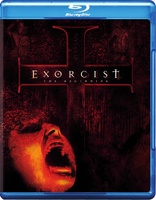
Movie rating
5.2 | / 10 |
Blu-ray rating
| Users | 3.2 | |
| Reviewer | 3.0 | |
| Overall | 3.0 |
Overview
Exorcist: The Beginning (2004)
Archeologist and former priest Lankester Merrin is hired to excavate a church that has been found buried in sands of British East Africa. Accompanied by a young priest, Father Francis, Merrin discovers an ancient hiding place where evil has been buried for centuries.
Starring: Stellan Skarsgård, Izabella Scorupco, James D'Arcy, Remy Sweeney, Julian WadhamDirector: Renny Harlin
| Horror | Uncertain |
| Thriller | Uncertain |
| Supernatural | Uncertain |
| Mystery | Uncertain |
Specifications
Video
Video codec: MPEG-4 AVC
Video resolution: 1080p
Aspect ratio: 2.35:1
Original aspect ratio: 2.00:1
Audio
English: DTS-HD Master Audio 5.1 (48kHz, 24-bit)
French: Dolby Digital 5.1 (640 kbps)
German: Dolby Digital 5.1 (640 kbps)
Spanish: Dolby Digital 5.1 (640 kbps)
Spanish: Dolby Digital 2.0 (192 kbps)
Portuguese: Dolby Digital 5.1 (640 kbps)
Japanese: Dolby Digital 5.1
Spanish 2.0=Latin; Japanese is hidden
Subtitles
English SDH, French, German SDH, Japanese, Portuguese, Spanish, Dutch
Discs
25GB Blu-ray Disc
Single disc (1 BD)
Playback
Region A (B, C untested)
Review
Rating summary
| Movie | 2.5 | |
| Video | 3.5 | |
| Audio | 4.0 | |
| Extras | 2.5 | |
| Overall | 3.0 |
Exorcist: The Beginning Blu-ray Movie Review
Raiders of the Mummy's One Ring on Cutthroat Island
Reviewed by Michael Reuben September 27, 2014Exorcist: The Beginning is being released both separately and as part of The Exorcist: The Complete Anthology. When Morgan Creek decided to shelve director Paul Schrader's effort at an Exorcist prequel (subsequently released as Dominion: Prequel to The Exorcist), it turned to Finnish action director Renny Harlin, the helmer of Die Hard 2, Cliffhanger, The Long Kiss Goodnight and Cutthroat Island. In other words, Morgan Creek jumped from a creator of art house fare to a maker of summer blockbusters (though not all of them paid off), because the arty guy hadn't made a scary enough movie for their box office hopes. They also gave Harlin twice the budget they'd allowed Schrader, which, at $60 milllion, was still less than Harlin was used to (a point he stresses in his commentary). After a complete overhaul of the script by Alexi Hawley (who has since written for the TV series Castle, Body of Proof and The Following), Harlin recast key roles and jumped into an accelerated production schedule for an August 2004 opening. Morgan Creek got exactly what they wanted. It just wasn't an Exorcist film. Harlin correctly recognized that the movie audience had changed since William Friedkin's 1973 classic, but somehow he convinced himself that grafting a slew of references to the original Exorcist onto an inflated tale of huge battles, far-fetched conspiracies, gory effects and over-the-top action sequences—enhanced with rapid cutting and the latest in CGI—would create a film that would stand out from the pack. It didn't. If anything, the film suffered by comparison both to Friedkin's original and to the much grander fantasy spectacles being created by the likes of Peter Jackson, whose Lord of the Rings trilogy Harlin was clearly trying to evoke with the opening of Beginning. But the essence of both Friedkin's original and the initial prequel script written by William Wisher and Caleb Carr was its intimate focus on individuals. Such material has never been Harlin's strength. Instead of chasing an elusive blockbuster audience, Morgan Creek would have been better off shelving the notion of an Exorcist prequel altogether. (For further information on the troubled history of the Exorcist prequel, please see the Blu-ray review of Dominion: Prequel to The Exorcist.)
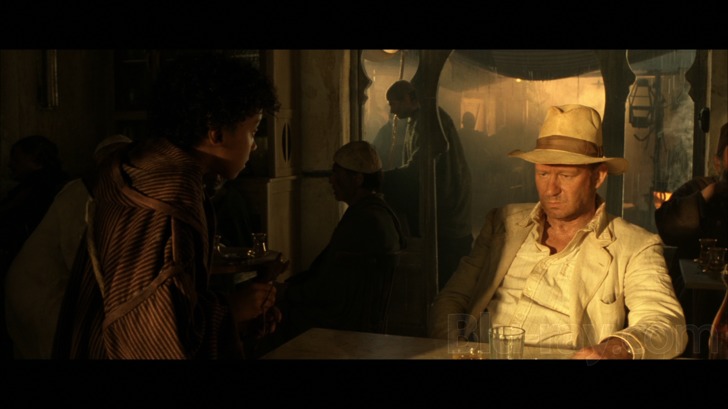
As with Schrader's Dominion, Beginning purports to tell the backstory of Father Lankester Merrin (played again, but in a subtly different performance, by Stellan Skarsgård). The difference in Harlin's approach is immediately established by his opening. Harlin begins not with Merrin but on a vast medieval battlefield strewn with corpses, where a lone knight experiences a horrific vision. The significance of both the battle and the vision will not be revealed until much later in the film, but it becomes part of an explanation for elements that the original script deliberately left vague. The explanation, when it arrives, does not strengthen the film. In matters as delicate as religious faith, some things are better left unsaid. Merrin's World War II experiences remain a part of the story, but they do not emerge until late in Beginning. We are supposed to wonder why he is no longer a priest when we find him in Cairo in 1949 as a kind of Indiana Jones figure (even Harlin acknowledges the inevitable comparison) being hired by a mysterious figure named Semelier (Ben Cross) to travel to the Turkana Region of Kenya where a British team is excavating a Christian church that dates back to 500 B.C., long before Christianity is known to have reached the region. Semelier wants Merrin to retrieve a specific relic he believes to be buried at the site. Then he hands Merrin a likeness that anyone familiar with The Exorcist will recognize as a figure of the demon Pazuzu. Merrin journeys to the dig, which, as before, is under the jurisdiction of British Major Granville (Julian Wadham, returning in the same part) with a Vatican priest named Father Francis assigned to the project (now played by James D'Arcy). The local doctor, Sarah, is now played by former Bond girl Izabella Scorupco (GoldenEye), and the sons of hotel owner Emekwi (Eddie Osei), James and Joseph, are now played by James Bellamy and the angel-faced Remy Sweeney. It is Joseph, the younger one, whom Merrin befriends, and it is Joseph whose behavior seems to change as the demonic presence beneath the buried church begins to manifest its presence. Indeed, the manifestations have already begun before Merrin arrives. The chief of the project, a brute named Jefferies (Alan Ford), has broken out in boils across his face, which will gradually worsen until they ultimately erupt in something even more revolting. Jefferies' condition doesn't stop him from making lewd advances toward Sarah, which progress to the point of assault. The chief archaeologist, Bession (Patrick O'Kane), went insane several weeks earlier and had to be confined to a mental ward in Nairobi. When Merrin enters the man's former tent, he finds that Bession was obsessively drawing the demonic figure that Merrin was shown in Cairo, and when he visits Bession in Nairobi, the encounter is grim and disturbing. Perhaps most shocking of all, when Merrin and Father Francis first enter the excavated church, they discover that someone has been there before them. The church has been desecrated is a very specific manner that viewers will recognize from the film's opening scene. As if all this weren't enough, Harlin throws in an elaborate attack by a pack of snarling, bloodthirsty jackals (computer-generated because, as Harlin explains in the commentary, real jackals don't do anything but sit there), a form of ritual exorcism by the local tribe involving leeches and incantations, a huge CG sandstorm, an athletic confrontation between Merrin and the demon that looks like something out of The Matrix and a bloody battle between the British army and the local tribe. In the midst of all this, Harlin does find a few moments for Merrin's troubled memories of his World War II horrors, but the impact isn't nearly the same, because Merrin is no longer the center of the film. He may be a key player, but he is still only a player in an epic tale that tried to encompass all of Christian history from the time of Lucifer's fall from heaven. (Yes, Lucifer's fall is an actual plot point.) It is possible to combine such a massive tale with an intense focus on the inner struggle of specific individuals, but only if you're working at epic length and have a writer who has imagined an entire world for the characters to inhabit, as Tolkien provided for Peter Jackson. And even if you have such a writer, Renny Harlin is the wrong director for the job. When we leave Father Merrin at the end of Beginning, he is once again a priest and carrying a stachel much like the one carried by Max Von Sydow when he arrives at the MacNeil home in Georgetown in Friedkin's film. As Harlin makes clear in his commentary, this is one of several visual cues intended to establish continuity between the two films, but it lacks any emotional heft. Despite Stellan Skarsgård's best efforts, Harlin hasn't given him enough opportunity to show Father Merrin's inner struggle and his rediscovery of his faith, because he's been too busy trying to wow the audience—or at least the Morgan Creek executives—with shocks and effects we've seen done better elsewhere. Merrin may be carrying the valise, but it doesn't feel like something uniquely his. It's as generic as a gunslinger's pistol.
Exorcist: The Beginning Blu-ray Movie, Video Quality 
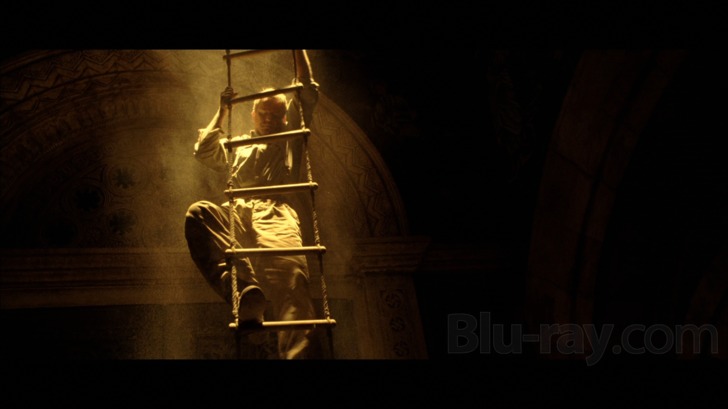
Like Dominion: Prequel to The Exorcist, Harlin's Exorcist: The Beginning was shot by Vittorio Storaro in his Univisium format, which is discussed in the Dominion Blu-ray review and has a native aspect ratio of 2.00:1. However, Harlin's preferred format is 2.35:1, which is how Beginning was released to theaters and is presented on Blu-ray, slightly cropping the Univisium image at top and bottom). Beginning was also Harlin's first film to be completed on a digital intermediate (an experience he describes in his commentary), which was still a relatively new process for feature films in 2004. Warner's 1080p, AVC-encoded Blu-ray was presumably sourced from digital files, although one cannot discount the possibility of further manipulation or filtering to facilitate the compression of this 114-minute film onto a BD-25 with an average bitrate of 17.74 Mbps. The Blu-ray image reproduces Storaro's trademark use of color as an expressive medium, which has become even more precise as a result of the DI process, with portions of the film being desaturated to the point of becoming almost black-and-white, while others are intense almost to the point of oversaturation. Blacks and shadows are precisely controlled and reproduced, as are densities and textures, although this doesn't always favor the CG shots. Detail is generally quite good, but the film's grain texture is virtually invisible, and it is impossible to say whether this occurred during the DI process or at a later stage (which is a big reason why DIs have mooted so many common elements of a Blu-ray evaluation).
Exorcist: The Beginning Blu-ray Movie, Audio Quality 
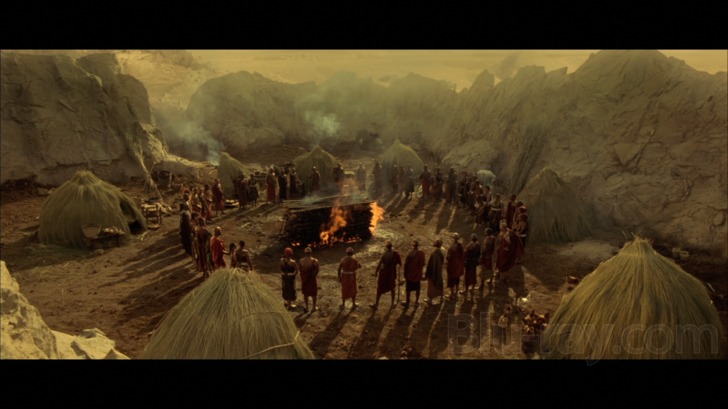
Beginning's 5.1 soundtrack, encoded on Blu-ray in lossless DTS-HD MA, provides the full-on sonic assault that one expects from a contemporary thiller-cum-action film, whether it's the blacksmiths pounding metal in the streets of Cairo (a deliberate reference to the opening of the original Exorcist, as Harlin confirms in his commentary), the demonic "stalking" of Dr. Sarah in her clinic, the attempted exorcism by the tribe of young Joseph, the supernatural sandstorm that isolates the dig site from the outside world or Merrin's climactic battle with the demon Pazuzu. Creaks, groans, winds, otherworldly voices, gunfire and other assorted noise take advantage of both the full surround array and the soundtrack's broad dynamic range. The dialogue is always clear, including the demon's vile pronouncements (although they're nowhere near as shocking as when twelve-year-old Regan spewed obscenities in 1973). Trevor Rabin supplied the action/adventure score.
Exorcist: The Beginning Blu-ray Movie, Special Features and Extras 
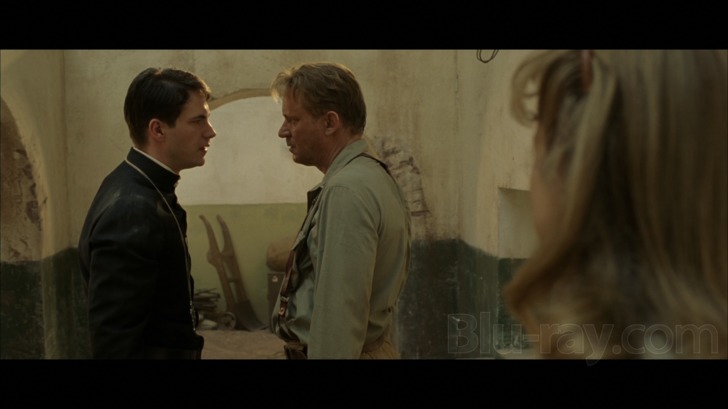
The extras have been ported over from Warner's 2005 DVD of The Beginning (with one possible question mark, noted below).
- Commentary with Director Renny Harlin: Harlin diplomatically avoids any discussion of the circumstances that led to his last-minute hiring, although he repeatedly refers to the abbreviated schedule and breakneck pace at which he was required to deliver The Beginning. His commentary is full of relevant technical detail about how the production was assembled, with almost everything shot on soundstages at Cinecittà studios, using digital effects to extend the backgrounds. He also comments on his casting, which resulted in replacing several of Schrader's key supporting actors, and discusses where he consciously chose to echo Friedkin's film and where he chose to depart from it. What's clear from Harlin's comments is that, within the limitations imposed upon him, he made the best Exorcist-style film he knew how to make.
- Behind the Scenes (480i; 1.33:1; 8:10): This is a brief but entertaining EPK featuring interviews with Harlin, Skarsgård, Scorupco and D'Arcy. It gives the bare outlines of the story and provides interesting trivia about the production.
- Trailer (480i; 2.35:1; 1:09): The odd thing about this trailer is that it uses a combination of scenes from the original film and Schrader's version. Now, it's possible that Harlin's film was shot so fast that no one had any opportunity to construct a trailer for it—it certainly wouldn't be the first time a trailer contained footage that didn't appear in the final release—but if anyone has the DVD of Beginning, please let me know whether it too contained a trailer featuring Gabriel Mann as Father Francis and the demon from Schrader's Dominion.
Exorcist: The Beginning Blu-ray Movie, Overall Score and Recommendation 
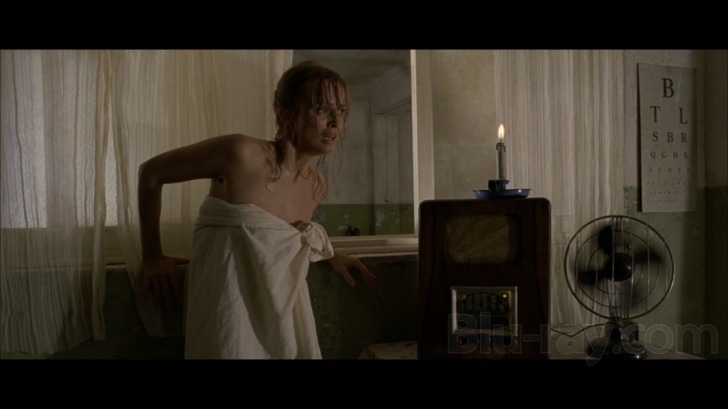
There's nothing especially wrong with Harlin's Exorcist prequel, but there's nothing memorable about it either. It leaves no strong impression, which is not the desired effect when you're trying to create an origin story for the title character of one of the greatest (if not the greatest) horror films in modern cinema. If the prequel's original director, John Frankenheimer, had lived to complete the project, he might well have made something as loud and boisterous as Harlin's movie, because Frankenheimer could direct action with the best of them (see, for example, his underrated Ronin). But Frankenheimer understood the importance of maintaining the focus on character, and that's what Beginning lacks. Not recommended on its own, but for students of the medium, Beginning and Dominion are fascinating companion pieces.
Similar titles
Similar titles you might also like

Dominion: Prequel to the Exorcist
2005

Exorcist II: The Heretic
Collector's Edition
1977

The Exorcist III 4K
Collector's Edition | + Director's Cut on BD
1990

The Exorcist 4K
50th Anniversary Edition
1973

Dust Devil 4K
Director's Cut
1992

The Black Castle
1952

Jason Goes to Hell: The Final Friday 4K
Limited Edition
1993

The Grudge
Unrated
2004

The Omen
1976

The Amityville Horror 4K
Collector's Edition
2005

Child's Play 4K
1988

The Ring 4K
2002

A Nightmare on Elm Street 4K
1984

Paranormal Activity 2
Unrated Director's Cut
2010

Final Destination 2
2003

The Nun
2018

Paranormal Activity
Theatrical + Unrated Alternate Cut
2007

Halloween III: Season of the Witch
Collector's Edition
1982

Halloween: The Curse of Michael Myers
Unrated Producer's Cut | Halloween 6
1995

The Witches
The Devil's Own
1966
